7 bungalows, a swimming pool and much more…
Djerba Island – Tunisia
« Tourism development shall be based on criteria of sustainability, which means that it must be ecologically bearable in the long term, as well as economically viable, and ethically and socially equitable for local communities. Tourism must consider its effects on the cultural heritage and traditional elements, activities and dynamics of each local community. Recognition of these local factors and support for the identity, culture and interests of the local community must at all times play a central role in the formulation of tourism strategies »
(Charter for Sustainable Tourism, April 1995)
Oxalá House intends to follow the guidelines laid down within the Tingitingi® Project, targeting a sustainable tourism.
Oxalá (pronounced o-cha-la) is a Portuguese interjection derived from the Arabic ‘Inshallah’, an expression of hope and humility.
Brought from East Africa, Tingitingi® is the Swahili word for “footbridge”. This is another word of hope (and modesty, because megalomania would have opted for a bridge instead of a footbridge) in the capacity of fair exchanges between men and women from different cultures to lay the foundations of a world of solidarity.
 Oxalá House fully follows the charter for Sustainable Tourism, and actively favors direct contact with local people. The residence only works with local communities and local service providers (housekeeping, child minding, tourist guides, sport discoveries, cultural/theme visits…) who are selected not only for the quality of their services, but also for their integrity and effective willingness to find a trade-off between economical viability and development issues.
Oxalá House fully follows the charter for Sustainable Tourism, and actively favors direct contact with local people. The residence only works with local communities and local service providers (housekeeping, child minding, tourist guides, sport discoveries, cultural/theme visits…) who are selected not only for the quality of their services, but also for their integrity and effective willingness to find a trade-off between economical viability and development issues.
Oxalá House aims to promote a fairer (environmentally/socially) sustainable tourism: tourism based on encounters of equals, benefiting both hosts and guests. Such a mutually beneficial exchange is supposed to allow local communities to value their natural, social and cultural resources without any big threat to their livelihoods, and allow travelers to gain new insights into the visited environment, its cultural diversity and its internal equilibrium forces.
About the residence…
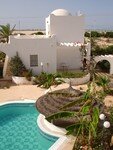
 Oxalá House is a charming residence with typical architecture (inspired from traditional « Menzels ») and an unbeatable view on the eastern costs of Jerba Island (Tunisia), carefully integrated within its natural environment of palm trees, prickly pears, aloes and agaves.
Oxalá House is a charming residence with typical architecture (inspired from traditional « Menzels ») and an unbeatable view on the eastern costs of Jerba Island (Tunisia), carefully integrated within its natural environment of palm trees, prickly pears, aloes and agaves.
Oxalá House is located at 700m from one of the nicest beaches of the Djerba island (Tunisia). It is composed of 7 fully/nicely furnished bungalows with cooking facilities and air-conditioning (both cooling and heating), set up around a central swimming pool, and ranging in size from cozy studios (max capacity = 2 pers.) to a spacious three-bedroom cottage (6 to 8 pers.).
Each bungalow has at least a private terrace with a view on the pool.
A detailed flyer, describing the residence and specially its underlying spirit, is available here:OxalaFlyer_Eng
For any additional information, please feel free to contact us at: tingitingi@live.fr
Rental Rates:
All our rates are expressed per bungalow and per night (check-in at 2 p.m., check-out at 12 a.m.).Rates 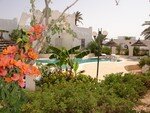 depend on season (High season – HS: July / Aug., Middle season – MS: Apr to June + Sep.) and length of stay. Discount rates are offered for extended rentals of 2 months or more.
depend on season (High season – HS: July / Aug., Middle season – MS: Apr to June + Sep.) and length of stay. Discount rates are offered for extended rentals of 2 months or more.
The Booking will be promptly confirmed by e-mail as soon as the required deposit (25% of the rental amount) is paid. A refundable security deposit (100€ for studios, 150€ for 1 and 2 bedroom flats, 200€ for the 3 bedroom cottage) shall be paid on the arrival date.
Additional beds could be provided for an extra charge of 7.5€ (LS) – 10€ (MS and HS). Baby beds are available on request.
All rental rates are available here: OxalaRates_Eng
How to get there?
Oxalá House is located on Jerba Island (probably, the dreamy land of Lotos-Eaters of Homer’s Odyssey). It is ideally situated in the area of Mezraya, between the island’s capital Houmt-Souk (8km, best-known for its traditional souk, its fortress and its silversmiths) and the typical village of Midoun (7km). It stands on the tourist road, at only 15km from the international airport of Jerba. Its whiteness will, no doubt, catch your sight just before reaching the Radisson SAS Resort (700m).
Avaialable activities:
Cycling, 18+9 hole golf course, Hiking / Rambling, Horse riding, Sea sports, Sailing, Diving, Museums, Roman sites, Casino, Bowling…
Please specify the desired capacity and ask about the available services (housekeeping, baby-sitting, car driver…) when making your reservation.
Some facts about our island:
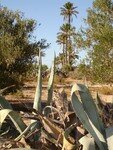
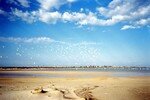 Djerba is an island situated off the southern coast of the Tunisian mainland. Its climate is mild. The summer (June to August) is usually hot and dry (75-95°F, 25-35°C). The coldest months are December through February (60-75°F, 15-25°C). Rain is occasional and there will almost never be two successive days when the sun is not shining.
Djerba is an island situated off the southern coast of the Tunisian mainland. Its climate is mild. The summer (June to August) is usually hot and dry (75-95°F, 25-35°C). The coldest months are December through February (60-75°F, 15-25°C). Rain is occasional and there will almost never be two successive days when the sun is not shining.
Besides its natural assets (beautiful scenery with thousands of palm trees, olive groves, impenetrable hedges of prickly pears enclosing the fields, endless white sandy beaches, 330 sunny days per year), the island offers plenty of social (typical dwellings known as Menzels, lively open air markets, active minorities), and cultural spots (hundreds of fortress like little mosques with characteristic minarets, small epicenter of Jewish culture, theme parks and museums, Ulysse festival in July, pottery and silversmith’s workshops, traditional olive oil press).
The numerous historic monuments (Roman ruins, Roman bridge linking the island to Zarzis area, numerous fortresses, El-Ghriba synagogue) testify to the eventful history of this strategic island, coveted by Mediterranean forces from time immemorial.
Jerba is one of the few remaining places in Tunisia where a Berber language is still spoken. The island is known for its Ibadite (a school of Islamic belief) and Jewish minorities.
Jerba is believed to be the island of the lotus-eaters on which Odysseus landed during his wanderings, as narrated in Homer’s Odyssey. Historical knowledge of the island goes back to the 9th century B.C., when the  Phoenicians established trading posts on what was known in antiquity as the island of Meninx. Over the following centuries it came under the control of the Romans, the Vandals, the Byzantines and Arabs (7th century). It was then captured by Normans from Sicily, temporarily ruled by the Spanish and became, at the end of the 15th century, notorious as a pirates’ lair. It was recovered from Spanish by the famous corsair Dragut who laid siege to their fortress (Borj Ghazi Mustapha), whose garrison of 5,000 men were compelled to surrender and were beheaded. Dragut had their skulls built up into a pyramid, which stood outside the fortress for almost 300 years, before being removed in 1848.
Phoenicians established trading posts on what was known in antiquity as the island of Meninx. Over the following centuries it came under the control of the Romans, the Vandals, the Byzantines and Arabs (7th century). It was then captured by Normans from Sicily, temporarily ruled by the Spanish and became, at the end of the 15th century, notorious as a pirates’ lair. It was recovered from Spanish by the famous corsair Dragut who laid siege to their fortress (Borj Ghazi Mustapha), whose garrison of 5,000 men were compelled to surrender and were beheaded. Dragut had their skulls built up into a pyramid, which stood outside the fortress for almost 300 years, before being removed in 1848.
Most tourists come to Jerba to lie on one beach or another, but there is much more to this island than swimming and windsurfing. The following attractions/visits are highly recommended:
- Houmt Souk’s market place, with its daily fish auction. You could also try the varied open-air markets (usually weekly) of other villages (Friday in Midoun, Saturday in El May, Monday and Thursday in Houmt-Souk, Sunday in Er-Riadh). Houmt Souk is also known for its silversmith’s workshops.
- Borj Ghazi Mustapha in Houmt-Souk: This fortress (mentioned above) was edified in 1289 by Roger de Loria (from Sicily and Aragon), occupied by Spanish and then strengthened by corsair Dragut (in 1557) for protection against Spanish reprisals.
- Borj Jillij, an 18th-century fortress, located on the coast near the airport. No doubt, you will notice the
 fishermen at work near the borj, probably setting out with boats piled high with palm leaves which they use to make fishing traps.
fishermen at work near the borj, probably setting out with boats piled high with palm leaves which they use to make fishing traps.
- Fadhloun mosque (14th century) with its « transcendent » architecture
- El-Ghriba Synagogue, a place of pilgrimage for Jews worldwide. Its foundations are thought to be 25 century old. One of the oldest Torahs in existence is located in this synagogue. Jewish people have lived here since 586BC, just after the destruction of King Solomon’s temple in Jerusalem.
- Saint Joseph’s church in Houmt-Souk
- The traditional olive oil press of Midoun, one of the last well preserved underground presses.
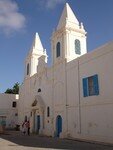 Pottery village of Guellala, where some (last few, unfortunately) potters still craft ceramics by hand.
Pottery village of Guellala, where some (last few, unfortunately) potters still craft ceramics by hand.
- Guellala Museum (located on Guellala hill) displays various scenes of traditional life and local architecture.
- Djerba Explore theme park with its 400-strong crocodile farm (a rather strange attraction) but also its Lalla Hadria Museum (covering a thousand years of art and history) and its traditional Menzel.
- Hiking (or cycling) through the island, especially around Midoun and Mahboubin villages, to discover the shady gardens of the interior, and orchards of fig, apple and pomegranate.
- Walking along the sandy (and preserved) beach, in front of the residence. You could wander until the Flamingo Island (8km walk).
- Jerba is also the gateway to the south. From here you can reach the vast depths of the Sahara Desert, as well as the Libyan desert.
Let’s dream together…
Jerba is probably the fabled land of the Lotus-Eaters that seduced Odysseus, as narrated in Homer’s Odyssey.
« Thereafter for nine days, I was driven by ravening winds across the sea. On the tenth day we made the land of the Lotos-eaters, men who browse on a food of flowers. We landed there to fill our water-butts, while my crews snatched a meal on the shore, beside their likely vessels. As soon as the first hunger for food and drink had passed, I chose out two fellows and added to them a third, as runner, that they might go inland to spy out and enquire what were the human beings there existing. Off they went at once and met a party of these Lotos-eaters, who had no notion of slaying my emissaries: instead they gave them a dish of their Lotos-flower. And so it was that as each tasted of this honey-sweet plant, the wish to bring news or return grew faint in him: rather he preferred to dwell for ever with the Lotos-eating men, feeding upon Lotos and letting fade from his mind all memory of home. I had to seek them and drag them back on board. They wept yet into the ships we brought them perforce and chained them beneath the thwarts, deep in the well, while I constrained the rest of my adherents to hurry aboard, lest perhaps more of them might eat Lotos and lose their longing for home. They embarked promptly and sat to the rowing benches; then in their proper ranks, all together, they swung their oars and beat the sea hoary-white. »
The Odyssey, Book IX, Homer. Translated by T.E. Lawrence (also known as Lawrence of Arabia 1888-1935)








